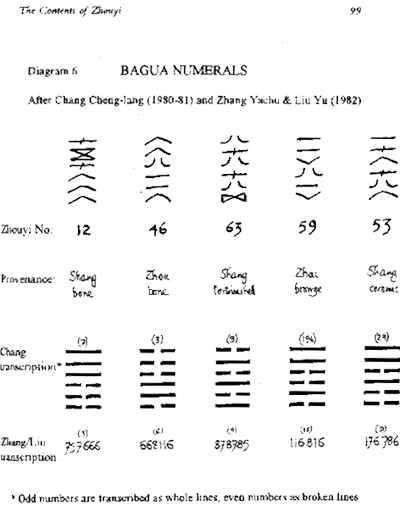I Ching, Yijing or Zhou Yi
"Oracle of the moon": © 2000 LiSe
 Yi Jing, Oracle of the Moon
Yi Jing, Oracle of the Moon


Richard Rutt
"Zhouyi, the book of changes"

In Rutt ("Zhouyi, the book of changes") is a picture of oracle-bone hexagrams. There are already open and closed lines. The open lines are written like a Chinese character 8. The numbers were different then, especially there were more numbers: examples below the row of ‘modern’ hexagrams: 1,5 and 7 are yang, 6 and 8 are yin). The numbers 1, 8 and 5 are still written aproximately like in the top hexagrams; 7 can be recognized, but is much simpler (its oldest form was a cross, GSR.400); 6 looked in former times like a house (GSR.1032), here only the roof is present. Its radical is 'divide' or 8: a 'divided' or even or yin number, like 8.
I quote: While it has been claimed that similar signs are found in Neolithic remains, the oldest reliably dated ones are from the reign of Wuding (c1238-1180 BC). … In 1978 Zhang Zhenglang propounded his theory that they are hexagrams. …Sometimes as numerals, sometimes as lines. Usually at the end of an inscription. ..The broken lines sometimes have three parts, rather than two. Groups of three numerals have also been found, but these tend to be of later date, well into Zhou times. This is the point that may have relevance to the historical relation between hexagrams and trigrams, favoring the thesis that hexagrams are older than trigrams, ..
Some scholars have wondered whether the counting of days in cycles of sixty, giving six ten-day ‘weeks’ to a cycle, underlies the hexagram form. In late Shang times tortoise-shell auguries were taken at the beginning of each ten-day period, on the Gui day (each ten day period begins with jia and ends with gui).
A page with more about the bagua numbers, probably the origin of Rutt's drawings, but hard to discern: click here